Hospitality Assignment 2022
VerifiedAdded on 2022/10/09
|15
|4147
|21
Assignment
AI Summary
Contribute Materials
Your contribution can guide someone’s learning journey. Share your
documents today.
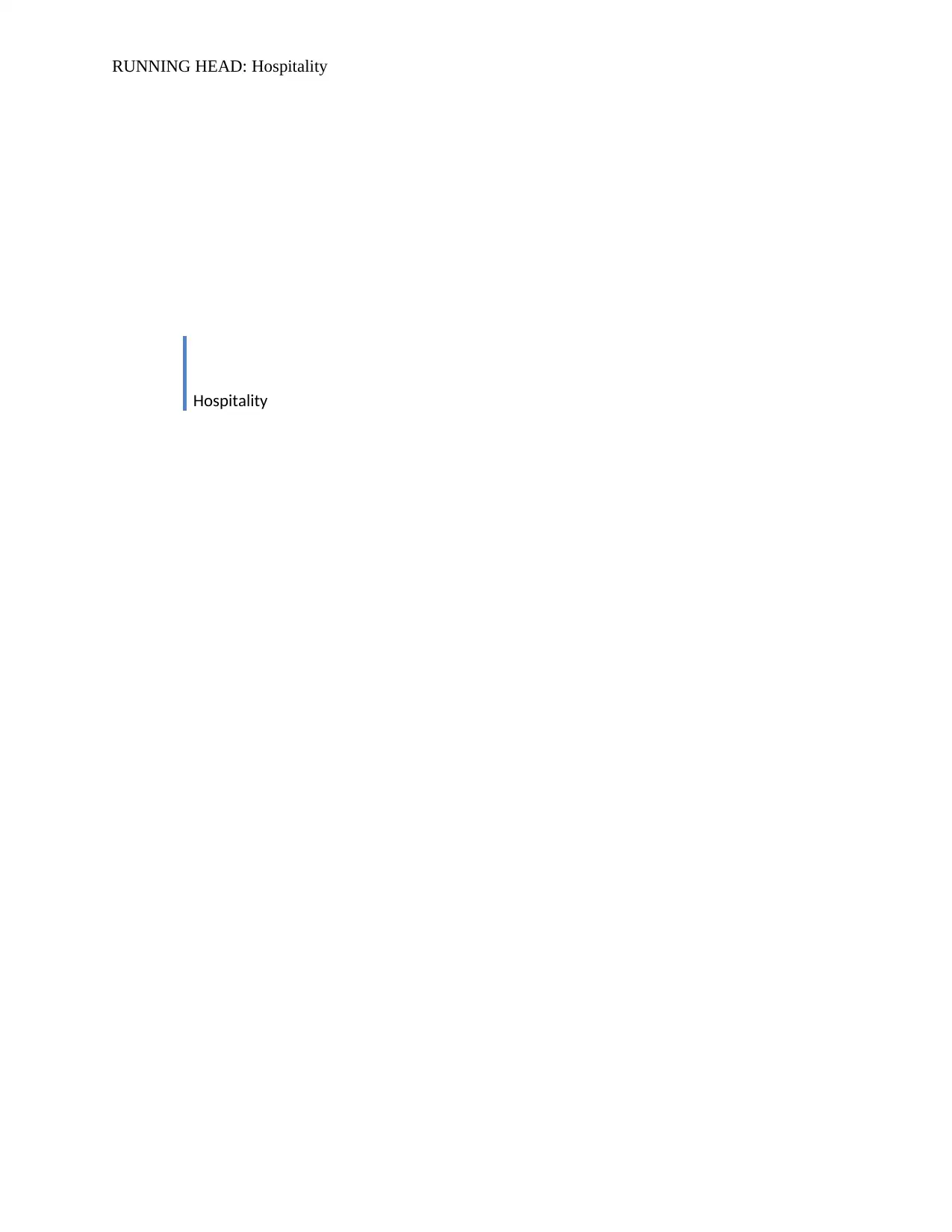
RUNNING HEAD: Hospitality
Hospitality
Hospitality
Secure Best Marks with AI Grader
Need help grading? Try our AI Grader for instant feedback on your assignments.
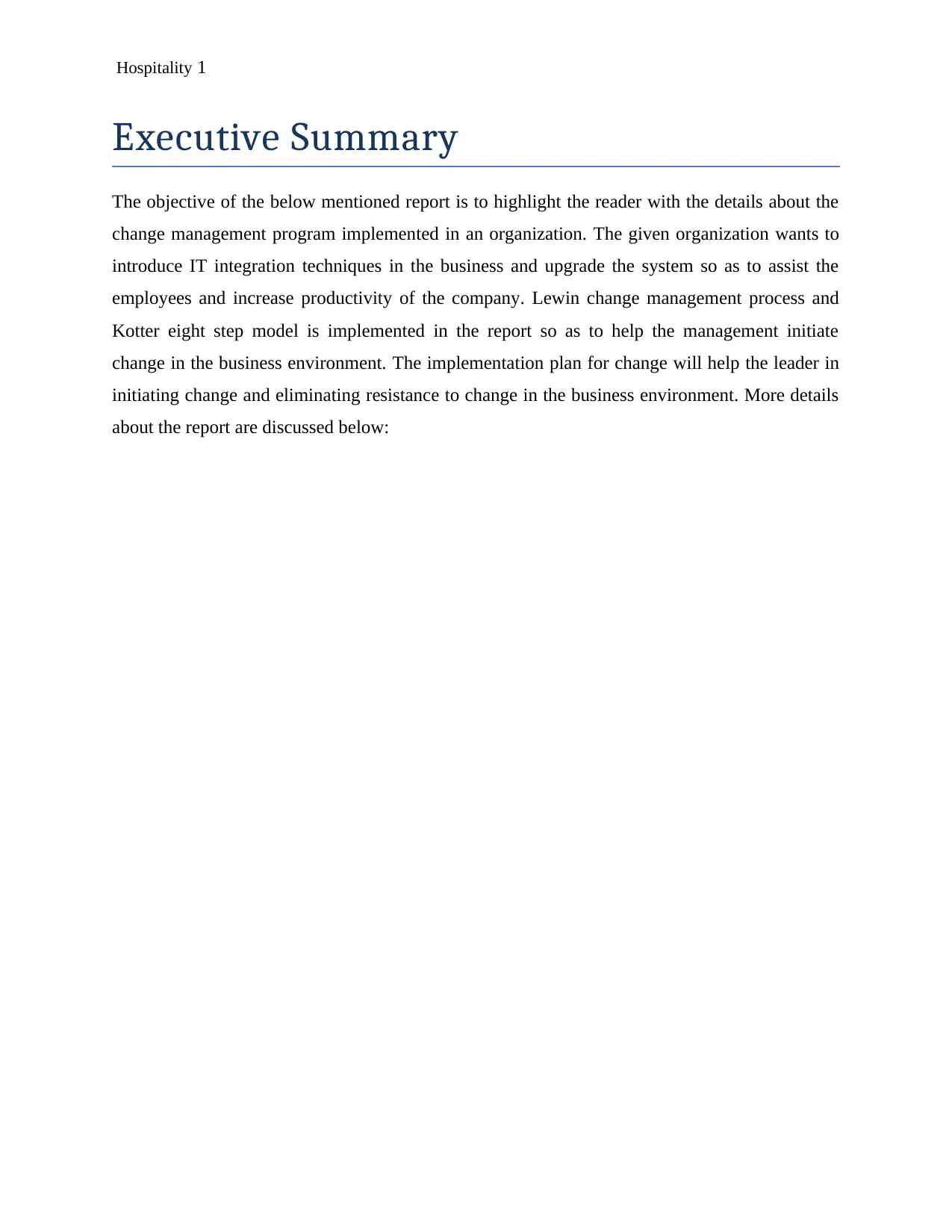
Hospitality 1
Executive Summary
The objective of the below mentioned report is to highlight the reader with the details about the
change management program implemented in an organization. The given organization wants to
introduce IT integration techniques in the business and upgrade the system so as to assist the
employees and increase productivity of the company. Lewin change management process and
Kotter eight step model is implemented in the report so as to help the management initiate
change in the business environment. The implementation plan for change will help the leader in
initiating change and eliminating resistance to change in the business environment. More details
about the report are discussed below:
Executive Summary
The objective of the below mentioned report is to highlight the reader with the details about the
change management program implemented in an organization. The given organization wants to
introduce IT integration techniques in the business and upgrade the system so as to assist the
employees and increase productivity of the company. Lewin change management process and
Kotter eight step model is implemented in the report so as to help the management initiate
change in the business environment. The implementation plan for change will help the leader in
initiating change and eliminating resistance to change in the business environment. More details
about the report are discussed below:
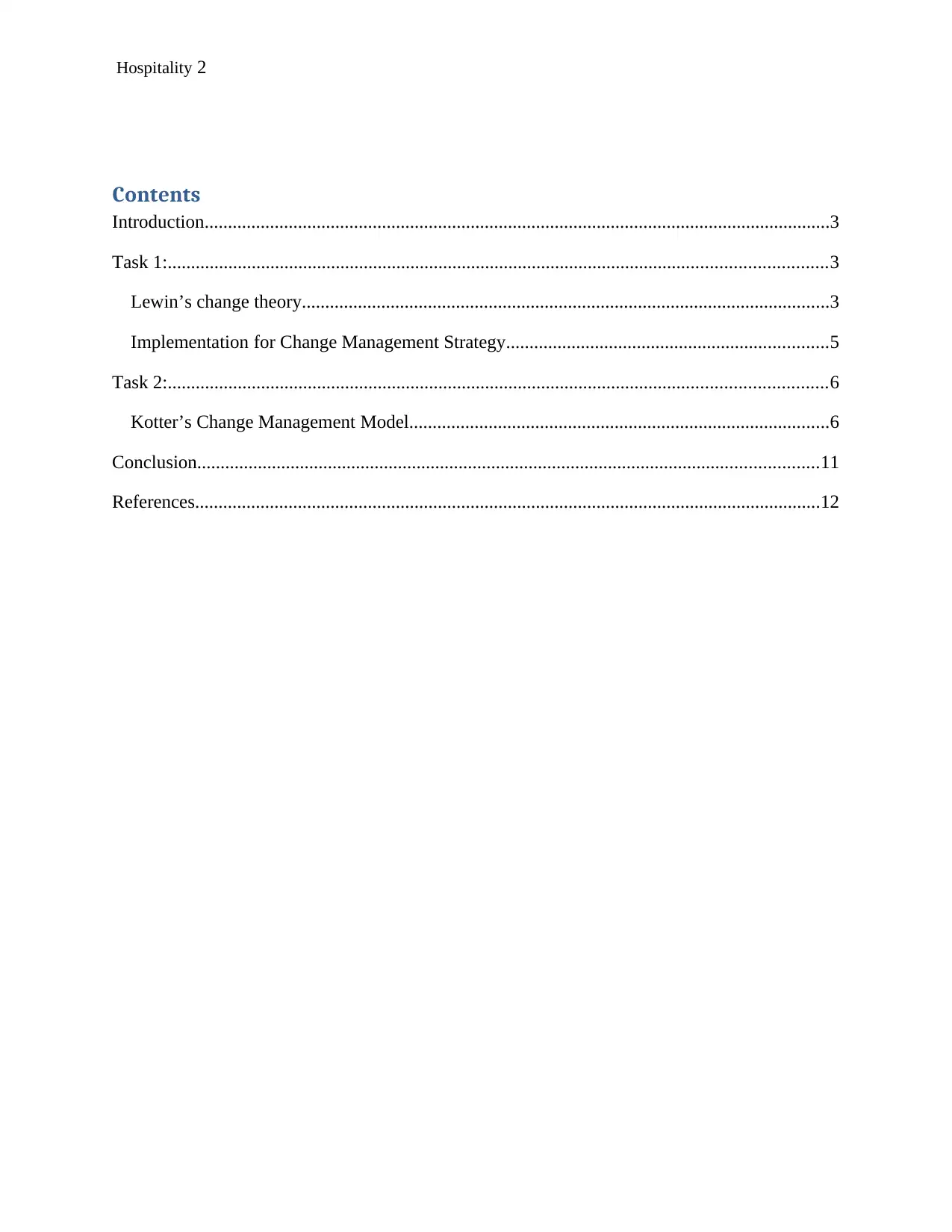
Hospitality 2
Contents
Introduction......................................................................................................................................3
Task 1:.............................................................................................................................................3
Lewin’s change theory.................................................................................................................3
Implementation for Change Management Strategy.....................................................................5
Task 2:.............................................................................................................................................6
Kotter’s Change Management Model..........................................................................................6
Conclusion.....................................................................................................................................11
References......................................................................................................................................12
Contents
Introduction......................................................................................................................................3
Task 1:.............................................................................................................................................3
Lewin’s change theory.................................................................................................................3
Implementation for Change Management Strategy.....................................................................5
Task 2:.............................................................................................................................................6
Kotter’s Change Management Model..........................................................................................6
Conclusion.....................................................................................................................................11
References......................................................................................................................................12
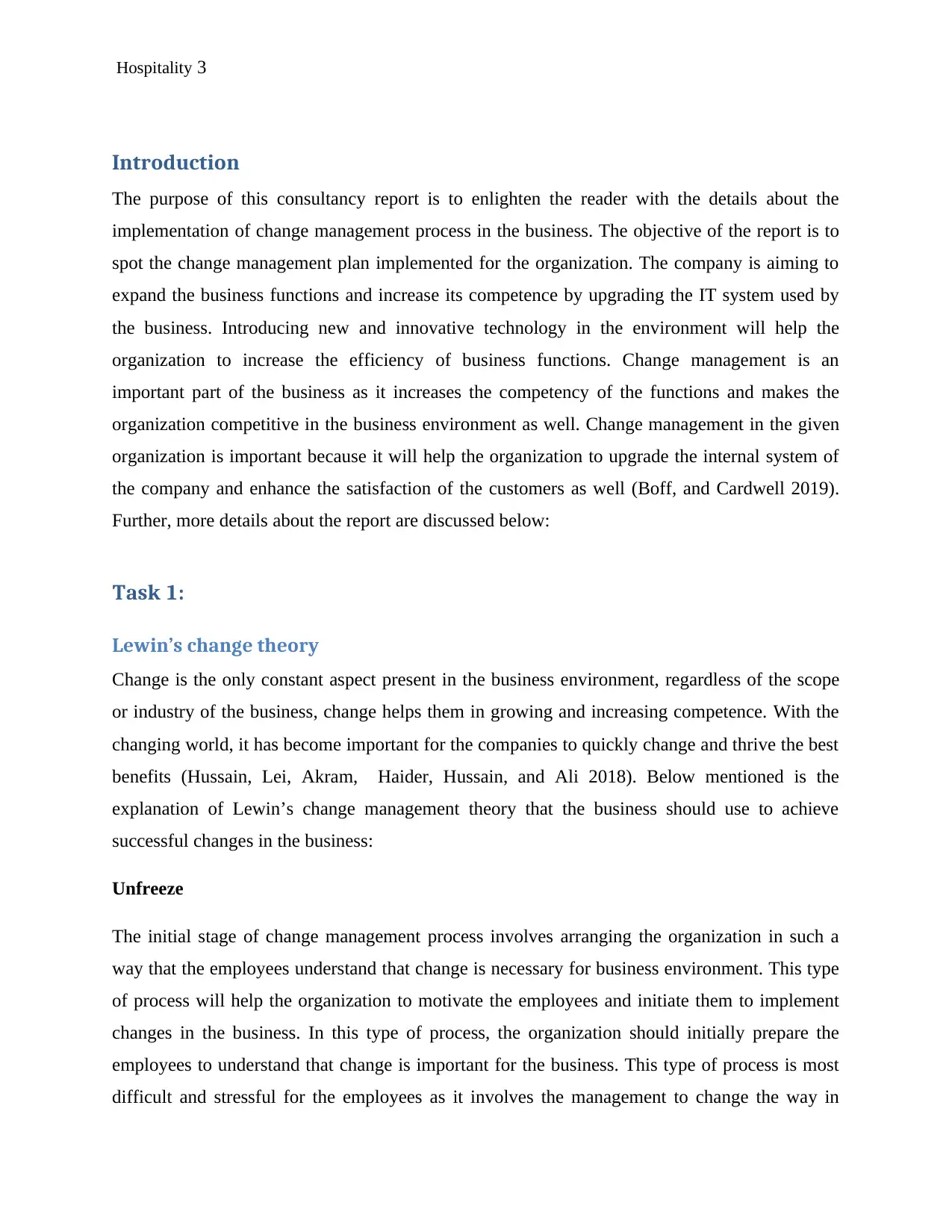
Hospitality 3
Introduction
The purpose of this consultancy report is to enlighten the reader with the details about the
implementation of change management process in the business. The objective of the report is to
spot the change management plan implemented for the organization. The company is aiming to
expand the business functions and increase its competence by upgrading the IT system used by
the business. Introducing new and innovative technology in the environment will help the
organization to increase the efficiency of business functions. Change management is an
important part of the business as it increases the competency of the functions and makes the
organization competitive in the business environment as well. Change management in the given
organization is important because it will help the organization to upgrade the internal system of
the company and enhance the satisfaction of the customers as well (Boff, and Cardwell 2019).
Further, more details about the report are discussed below:
Task 1:
Lewin’s change theory
Change is the only constant aspect present in the business environment, regardless of the scope
or industry of the business, change helps them in growing and increasing competence. With the
changing world, it has become important for the companies to quickly change and thrive the best
benefits (Hussain, Lei, Akram, Haider, Hussain, and Ali 2018). Below mentioned is the
explanation of Lewin’s change management theory that the business should use to achieve
successful changes in the business:
Unfreeze
The initial stage of change management process involves arranging the organization in such a
way that the employees understand that change is necessary for business environment. This type
of process will help the organization to motivate the employees and initiate them to implement
changes in the business. In this type of process, the organization should initially prepare the
employees to understand that change is important for the business. This type of process is most
difficult and stressful for the employees as it involves the management to change the way in
Introduction
The purpose of this consultancy report is to enlighten the reader with the details about the
implementation of change management process in the business. The objective of the report is to
spot the change management plan implemented for the organization. The company is aiming to
expand the business functions and increase its competence by upgrading the IT system used by
the business. Introducing new and innovative technology in the environment will help the
organization to increase the efficiency of business functions. Change management is an
important part of the business as it increases the competency of the functions and makes the
organization competitive in the business environment as well. Change management in the given
organization is important because it will help the organization to upgrade the internal system of
the company and enhance the satisfaction of the customers as well (Boff, and Cardwell 2019).
Further, more details about the report are discussed below:
Task 1:
Lewin’s change theory
Change is the only constant aspect present in the business environment, regardless of the scope
or industry of the business, change helps them in growing and increasing competence. With the
changing world, it has become important for the companies to quickly change and thrive the best
benefits (Hussain, Lei, Akram, Haider, Hussain, and Ali 2018). Below mentioned is the
explanation of Lewin’s change management theory that the business should use to achieve
successful changes in the business:
Unfreeze
The initial stage of change management process involves arranging the organization in such a
way that the employees understand that change is necessary for business environment. This type
of process will help the organization to motivate the employees and initiate them to implement
changes in the business. In this type of process, the organization should initially prepare the
employees to understand that change is important for the business. This type of process is most
difficult and stressful for the employees as it involves the management to change the way in
Secure Best Marks with AI Grader
Need help grading? Try our AI Grader for instant feedback on your assignments.

Hospitality 4
which things are usually done (Cummings, Bridgman, and Brown 2016). After communicating
the need for change to the employees, it become crucial for the organization to let them adopt the
change as well. Usually employees resist implementing change management activities in the
business environment, as they believe that change management activities increases their burden
to work. The top-level management of the company only suggests change but it is implemented
by the middle and lower level employees therefore, it is important for the company to attain the
approval of the employees before implementing any change management activity in the business
environment. Under the unfreeze activity the management of the company should make sure that
the employees understand the change and the concept that the business is aiming to implement in
the environment. This is the stage where the employees will resist towards change and the
management will implement activities to eliminate the level of resistance from the business
environment (Hossan 2015).
Change
After eliminating the resistance to change aspect from the mind-set of the employees, the
organization should now actually implement the change in the workings of the business. At this
stage, the business will make the employees adopt the change in the business and focus on
implementing the activities that involve the application of change. In this stage, the organization
will monitor the ways in which the employees conduct the changes in their activities so as to
attain the objective of the company. The organization creates a plan and defines activities in
which they will implement changes in the business. At this time, the business will also face
several issues in the environment that would eliminate the competence of change management
activity. So, the organization will aim to resolve the issues faced by employees while
implementing changes in the business (Tang 2019).
Refreeze
At this stage, the business will again refreeze the environment that they wanted to change.
According to this model of change, the organization initially unfreezes the business environment
so as to implement change and make the employees comfortable with the change. Once the
change has been adopted by the employees, then the management again refreeze the environment
so that the change management activities are securely implemented in the environment. At this
which things are usually done (Cummings, Bridgman, and Brown 2016). After communicating
the need for change to the employees, it become crucial for the organization to let them adopt the
change as well. Usually employees resist implementing change management activities in the
business environment, as they believe that change management activities increases their burden
to work. The top-level management of the company only suggests change but it is implemented
by the middle and lower level employees therefore, it is important for the company to attain the
approval of the employees before implementing any change management activity in the business
environment. Under the unfreeze activity the management of the company should make sure that
the employees understand the change and the concept that the business is aiming to implement in
the environment. This is the stage where the employees will resist towards change and the
management will implement activities to eliminate the level of resistance from the business
environment (Hossan 2015).
Change
After eliminating the resistance to change aspect from the mind-set of the employees, the
organization should now actually implement the change in the workings of the business. At this
stage, the business will make the employees adopt the change in the business and focus on
implementing the activities that involve the application of change. In this stage, the organization
will monitor the ways in which the employees conduct the changes in their activities so as to
attain the objective of the company. The organization creates a plan and defines activities in
which they will implement changes in the business. At this time, the business will also face
several issues in the environment that would eliminate the competence of change management
activity. So, the organization will aim to resolve the issues faced by employees while
implementing changes in the business (Tang 2019).
Refreeze
At this stage, the business will again refreeze the environment that they wanted to change.
According to this model of change, the organization initially unfreezes the business environment
so as to implement change and make the employees comfortable with the change. Once the
change has been adopted by the employees, then the management again refreeze the environment
so that the change management activities are securely implemented in the environment. At this
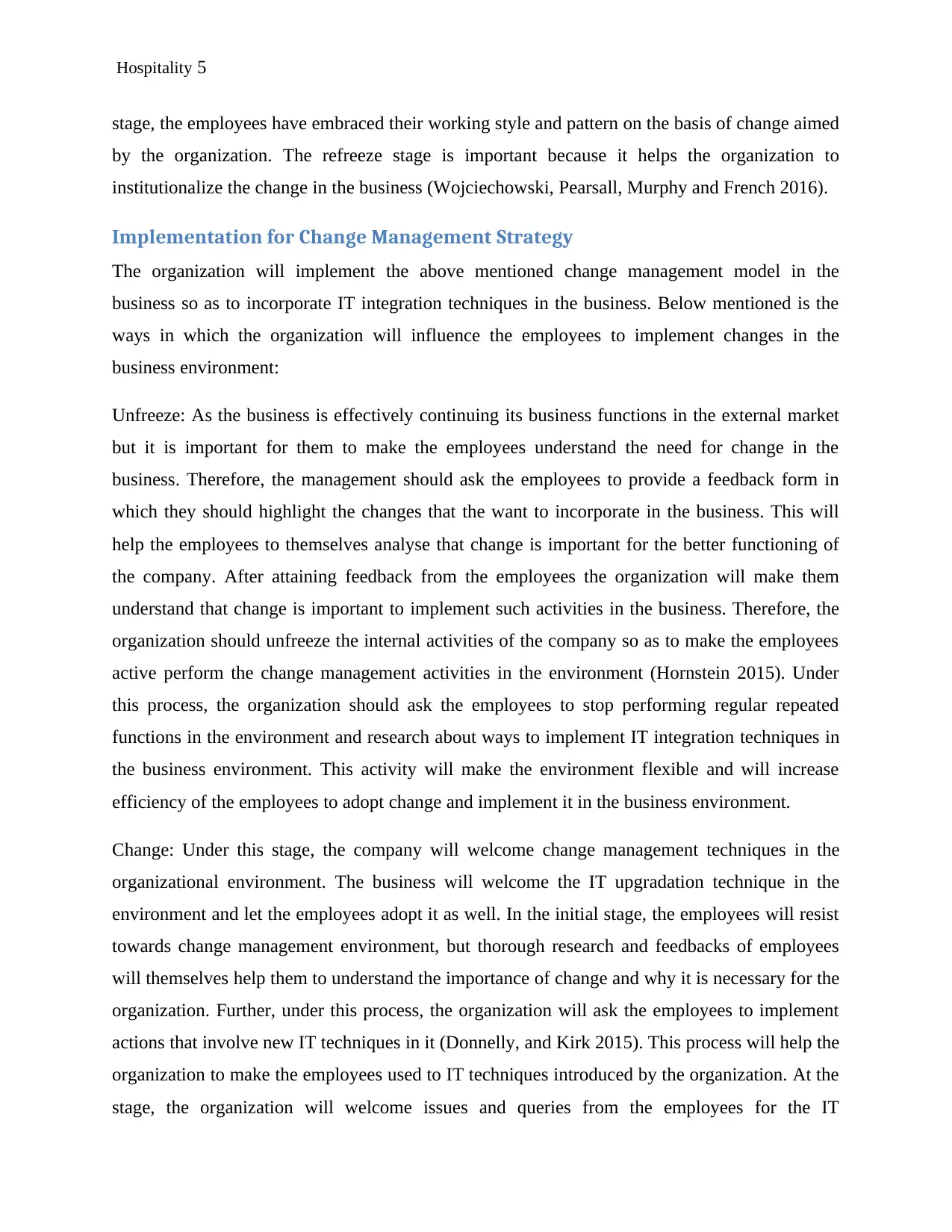
Hospitality 5
stage, the employees have embraced their working style and pattern on the basis of change aimed
by the organization. The refreeze stage is important because it helps the organization to
institutionalize the change in the business (Wojciechowski, Pearsall, Murphy and French 2016).
Implementation for Change Management Strategy
The organization will implement the above mentioned change management model in the
business so as to incorporate IT integration techniques in the business. Below mentioned is the
ways in which the organization will influence the employees to implement changes in the
business environment:
Unfreeze: As the business is effectively continuing its business functions in the external market
but it is important for them to make the employees understand the need for change in the
business. Therefore, the management should ask the employees to provide a feedback form in
which they should highlight the changes that the want to incorporate in the business. This will
help the employees to themselves analyse that change is important for the better functioning of
the company. After attaining feedback from the employees the organization will make them
understand that change is important to implement such activities in the business. Therefore, the
organization should unfreeze the internal activities of the company so as to make the employees
active perform the change management activities in the environment (Hornstein 2015). Under
this process, the organization should ask the employees to stop performing regular repeated
functions in the environment and research about ways to implement IT integration techniques in
the business environment. This activity will make the environment flexible and will increase
efficiency of the employees to adopt change and implement it in the business environment.
Change: Under this stage, the company will welcome change management techniques in the
organizational environment. The business will welcome the IT upgradation technique in the
environment and let the employees adopt it as well. In the initial stage, the employees will resist
towards change management environment, but thorough research and feedbacks of employees
will themselves help them to understand the importance of change and why it is necessary for the
organization. Further, under this process, the organization will ask the employees to implement
actions that involve new IT techniques in it (Donnelly, and Kirk 2015). This process will help the
organization to make the employees used to IT techniques introduced by the organization. At the
stage, the organization will welcome issues and queries from the employees for the IT
stage, the employees have embraced their working style and pattern on the basis of change aimed
by the organization. The refreeze stage is important because it helps the organization to
institutionalize the change in the business (Wojciechowski, Pearsall, Murphy and French 2016).
Implementation for Change Management Strategy
The organization will implement the above mentioned change management model in the
business so as to incorporate IT integration techniques in the business. Below mentioned is the
ways in which the organization will influence the employees to implement changes in the
business environment:
Unfreeze: As the business is effectively continuing its business functions in the external market
but it is important for them to make the employees understand the need for change in the
business. Therefore, the management should ask the employees to provide a feedback form in
which they should highlight the changes that the want to incorporate in the business. This will
help the employees to themselves analyse that change is important for the better functioning of
the company. After attaining feedback from the employees the organization will make them
understand that change is important to implement such activities in the business. Therefore, the
organization should unfreeze the internal activities of the company so as to make the employees
active perform the change management activities in the environment (Hornstein 2015). Under
this process, the organization should ask the employees to stop performing regular repeated
functions in the environment and research about ways to implement IT integration techniques in
the business environment. This activity will make the environment flexible and will increase
efficiency of the employees to adopt change and implement it in the business environment.
Change: Under this stage, the company will welcome change management techniques in the
organizational environment. The business will welcome the IT upgradation technique in the
environment and let the employees adopt it as well. In the initial stage, the employees will resist
towards change management environment, but thorough research and feedbacks of employees
will themselves help them to understand the importance of change and why it is necessary for the
organization. Further, under this process, the organization will ask the employees to implement
actions that involve new IT techniques in it (Donnelly, and Kirk 2015). This process will help the
organization to make the employees used to IT techniques introduced by the organization. At the
stage, the organization will welcome issues and queries from the employees for the IT

Hospitality 6
techniques. This stage will finally help the employees to test and try the new and innovative
technique and analyse the ways in which they can adopt it for the growth of the business. At the
end of this stage, the organization will be able to train employees to successfully implement the
IT techniques in their activities without facing any barriers in their activities (Loganathan 2019).
Refreeze: lastly, under this stage, the organization will again refreeze the business environment.
Refreeze under this case means that the organization ask the employees to implement the
modified techniques on a regular basis. Initially, the management itself asked the employees to
adopt new technologies and try it. After successful adoption of change from the end of
employees, it becomes important for the organization to again stabilize the environment because
if they will not restrict the environment then the employees will keep of changing their business
activities that will reduce the efficiency of the change (Hee, and Shanmugam 2019). Therefore,
once desired change management activities are implemented and adopted by the employees, then
the organization need to again refreeze the workplace environment.
Thus, in this way, the organization should implement the change management activities in the
business environment so as to make the employees comfortable with the IT upgradation change
and adopt it to increase the efficiency of the business (Bejinariu, et. al., 2017).
Task 2:
Kotter’s Change Management Model
In the year 1996, John Kotter wrote Leading Change book that evaluated the ways implemented
by people to transform or implement change in the business. He introduced 8 step change
management model for assisting the supervisors to deal with transformational change in the
environment. Therefore, this model is known as Kotter 8 step change management model that
articulate the ways in which companies can initiate change management in the business process
(Teixeira, Gregory, and Austin 2017). Below mentioned is the analysis of the change
implemented in the given organization using Kotter’s 8 step change management techniques in
the business environment:
Step 1: Create urgency
techniques. This stage will finally help the employees to test and try the new and innovative
technique and analyse the ways in which they can adopt it for the growth of the business. At the
end of this stage, the organization will be able to train employees to successfully implement the
IT techniques in their activities without facing any barriers in their activities (Loganathan 2019).
Refreeze: lastly, under this stage, the organization will again refreeze the business environment.
Refreeze under this case means that the organization ask the employees to implement the
modified techniques on a regular basis. Initially, the management itself asked the employees to
adopt new technologies and try it. After successful adoption of change from the end of
employees, it becomes important for the organization to again stabilize the environment because
if they will not restrict the environment then the employees will keep of changing their business
activities that will reduce the efficiency of the change (Hee, and Shanmugam 2019). Therefore,
once desired change management activities are implemented and adopted by the employees, then
the organization need to again refreeze the workplace environment.
Thus, in this way, the organization should implement the change management activities in the
business environment so as to make the employees comfortable with the IT upgradation change
and adopt it to increase the efficiency of the business (Bejinariu, et. al., 2017).
Task 2:
Kotter’s Change Management Model
In the year 1996, John Kotter wrote Leading Change book that evaluated the ways implemented
by people to transform or implement change in the business. He introduced 8 step change
management model for assisting the supervisors to deal with transformational change in the
environment. Therefore, this model is known as Kotter 8 step change management model that
articulate the ways in which companies can initiate change management in the business process
(Teixeira, Gregory, and Austin 2017). Below mentioned is the analysis of the change
implemented in the given organization using Kotter’s 8 step change management techniques in
the business environment:
Step 1: Create urgency
Paraphrase This Document
Need a fresh take? Get an instant paraphrase of this document with our AI Paraphraser
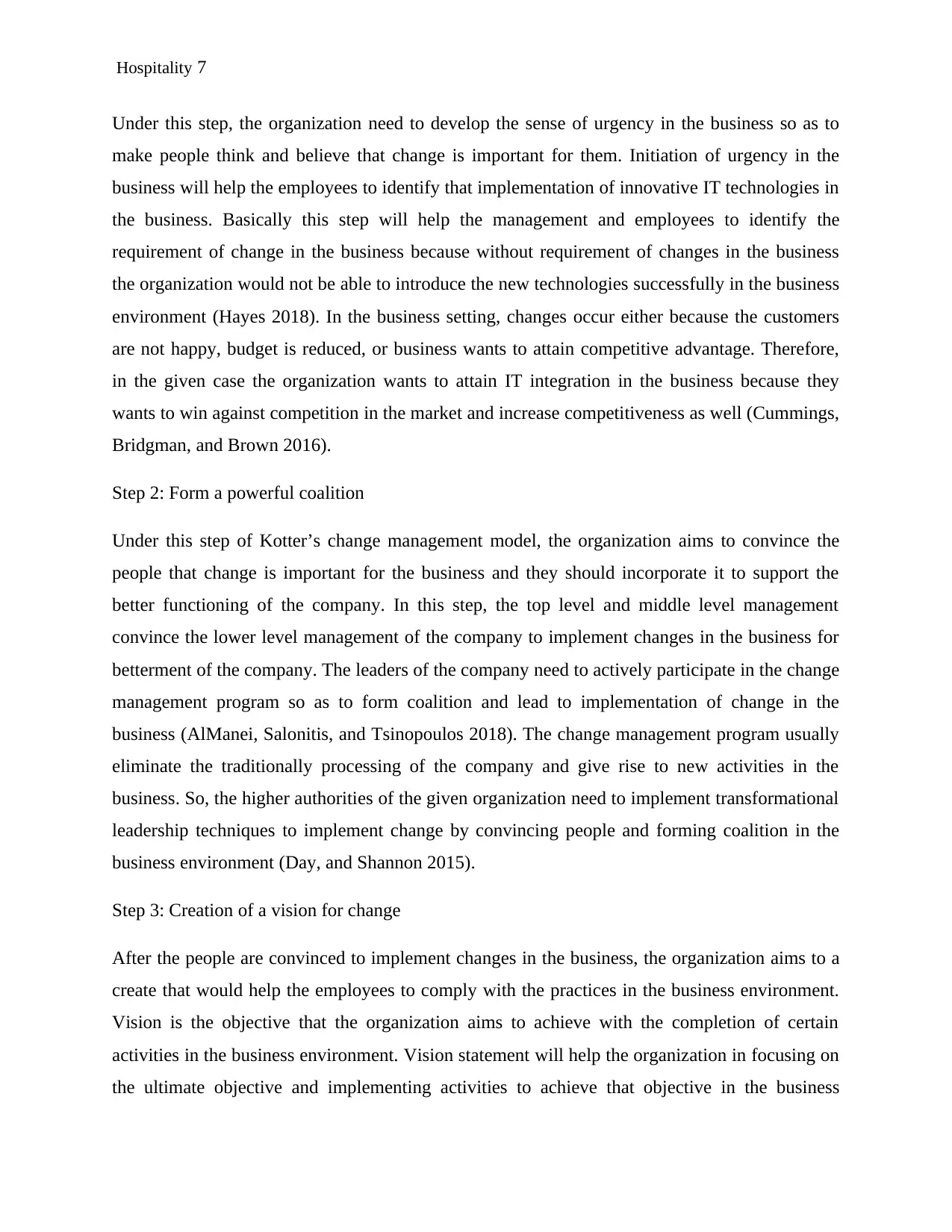
Hospitality 7
Under this step, the organization need to develop the sense of urgency in the business so as to
make people think and believe that change is important for them. Initiation of urgency in the
business will help the employees to identify that implementation of innovative IT technologies in
the business. Basically this step will help the management and employees to identify the
requirement of change in the business because without requirement of changes in the business
the organization would not be able to introduce the new technologies successfully in the business
environment (Hayes 2018). In the business setting, changes occur either because the customers
are not happy, budget is reduced, or business wants to attain competitive advantage. Therefore,
in the given case the organization wants to attain IT integration in the business because they
wants to win against competition in the market and increase competitiveness as well (Cummings,
Bridgman, and Brown 2016).
Step 2: Form a powerful coalition
Under this step of Kotter’s change management model, the organization aims to convince the
people that change is important for the business and they should incorporate it to support the
better functioning of the company. In this step, the top level and middle level management
convince the lower level management of the company to implement changes in the business for
betterment of the company. The leaders of the company need to actively participate in the change
management program so as to form coalition and lead to implementation of change in the
business (AlManei, Salonitis, and Tsinopoulos 2018). The change management program usually
eliminate the traditionally processing of the company and give rise to new activities in the
business. So, the higher authorities of the given organization need to implement transformational
leadership techniques to implement change by convincing people and forming coalition in the
business environment (Day, and Shannon 2015).
Step 3: Creation of a vision for change
After the people are convinced to implement changes in the business, the organization aims to a
create that would help the employees to comply with the practices in the business environment.
Vision is the objective that the organization aims to achieve with the completion of certain
activities in the business environment. Vision statement will help the organization in focusing on
the ultimate objective and implementing activities to achieve that objective in the business
Under this step, the organization need to develop the sense of urgency in the business so as to
make people think and believe that change is important for them. Initiation of urgency in the
business will help the employees to identify that implementation of innovative IT technologies in
the business. Basically this step will help the management and employees to identify the
requirement of change in the business because without requirement of changes in the business
the organization would not be able to introduce the new technologies successfully in the business
environment (Hayes 2018). In the business setting, changes occur either because the customers
are not happy, budget is reduced, or business wants to attain competitive advantage. Therefore,
in the given case the organization wants to attain IT integration in the business because they
wants to win against competition in the market and increase competitiveness as well (Cummings,
Bridgman, and Brown 2016).
Step 2: Form a powerful coalition
Under this step of Kotter’s change management model, the organization aims to convince the
people that change is important for the business and they should incorporate it to support the
better functioning of the company. In this step, the top level and middle level management
convince the lower level management of the company to implement changes in the business for
betterment of the company. The leaders of the company need to actively participate in the change
management program so as to form coalition and lead to implementation of change in the
business (AlManei, Salonitis, and Tsinopoulos 2018). The change management program usually
eliminate the traditionally processing of the company and give rise to new activities in the
business. So, the higher authorities of the given organization need to implement transformational
leadership techniques to implement change by convincing people and forming coalition in the
business environment (Day, and Shannon 2015).
Step 3: Creation of a vision for change
After the people are convinced to implement changes in the business, the organization aims to a
create that would help the employees to comply with the practices in the business environment.
Vision is the objective that the organization aims to achieve with the completion of certain
activities in the business environment. Vision statement will help the organization in focusing on
the ultimate objective and implementing activities to achieve that objective in the business
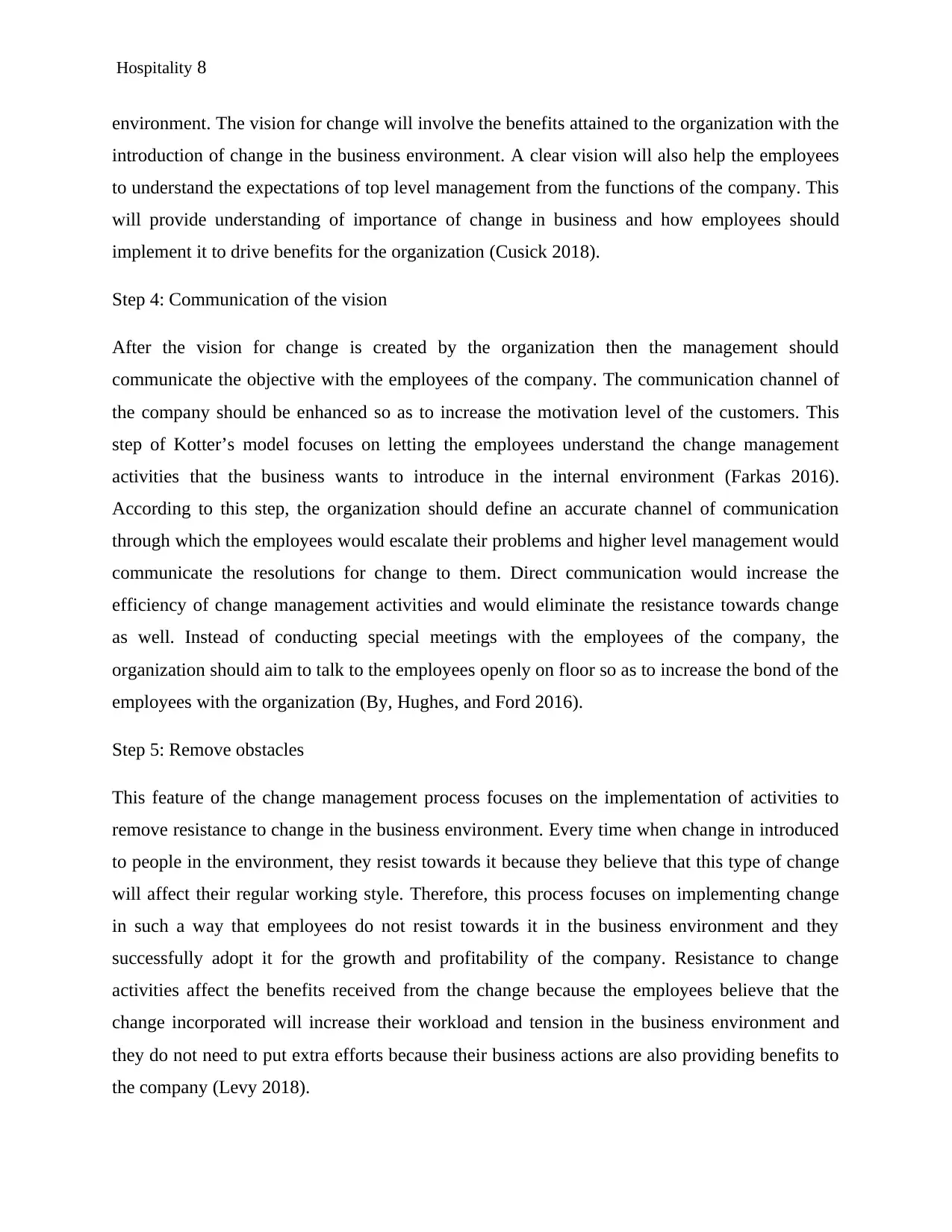
Hospitality 8
environment. The vision for change will involve the benefits attained to the organization with the
introduction of change in the business environment. A clear vision will also help the employees
to understand the expectations of top level management from the functions of the company. This
will provide understanding of importance of change in business and how employees should
implement it to drive benefits for the organization (Cusick 2018).
Step 4: Communication of the vision
After the vision for change is created by the organization then the management should
communicate the objective with the employees of the company. The communication channel of
the company should be enhanced so as to increase the motivation level of the customers. This
step of Kotter’s model focuses on letting the employees understand the change management
activities that the business wants to introduce in the internal environment (Farkas 2016).
According to this step, the organization should define an accurate channel of communication
through which the employees would escalate their problems and higher level management would
communicate the resolutions for change to them. Direct communication would increase the
efficiency of change management activities and would eliminate the resistance towards change
as well. Instead of conducting special meetings with the employees of the company, the
organization should aim to talk to the employees openly on floor so as to increase the bond of the
employees with the organization (By, Hughes, and Ford 2016).
Step 5: Remove obstacles
This feature of the change management process focuses on the implementation of activities to
remove resistance to change in the business environment. Every time when change in introduced
to people in the environment, they resist towards it because they believe that this type of change
will affect their regular working style. Therefore, this process focuses on implementing change
in such a way that employees do not resist towards it in the business environment and they
successfully adopt it for the growth and profitability of the company. Resistance to change
activities affect the benefits received from the change because the employees believe that the
change incorporated will increase their workload and tension in the business environment and
they do not need to put extra efforts because their business actions are also providing benefits to
the company (Levy 2018).
environment. The vision for change will involve the benefits attained to the organization with the
introduction of change in the business environment. A clear vision will also help the employees
to understand the expectations of top level management from the functions of the company. This
will provide understanding of importance of change in business and how employees should
implement it to drive benefits for the organization (Cusick 2018).
Step 4: Communication of the vision
After the vision for change is created by the organization then the management should
communicate the objective with the employees of the company. The communication channel of
the company should be enhanced so as to increase the motivation level of the customers. This
step of Kotter’s model focuses on letting the employees understand the change management
activities that the business wants to introduce in the internal environment (Farkas 2016).
According to this step, the organization should define an accurate channel of communication
through which the employees would escalate their problems and higher level management would
communicate the resolutions for change to them. Direct communication would increase the
efficiency of change management activities and would eliminate the resistance towards change
as well. Instead of conducting special meetings with the employees of the company, the
organization should aim to talk to the employees openly on floor so as to increase the bond of the
employees with the organization (By, Hughes, and Ford 2016).
Step 5: Remove obstacles
This feature of the change management process focuses on the implementation of activities to
remove resistance to change in the business environment. Every time when change in introduced
to people in the environment, they resist towards it because they believe that this type of change
will affect their regular working style. Therefore, this process focuses on implementing change
in such a way that employees do not resist towards it in the business environment and they
successfully adopt it for the growth and profitability of the company. Resistance to change
activities affect the benefits received from the change because the employees believe that the
change incorporated will increase their workload and tension in the business environment and
they do not need to put extra efforts because their business actions are also providing benefits to
the company (Levy 2018).
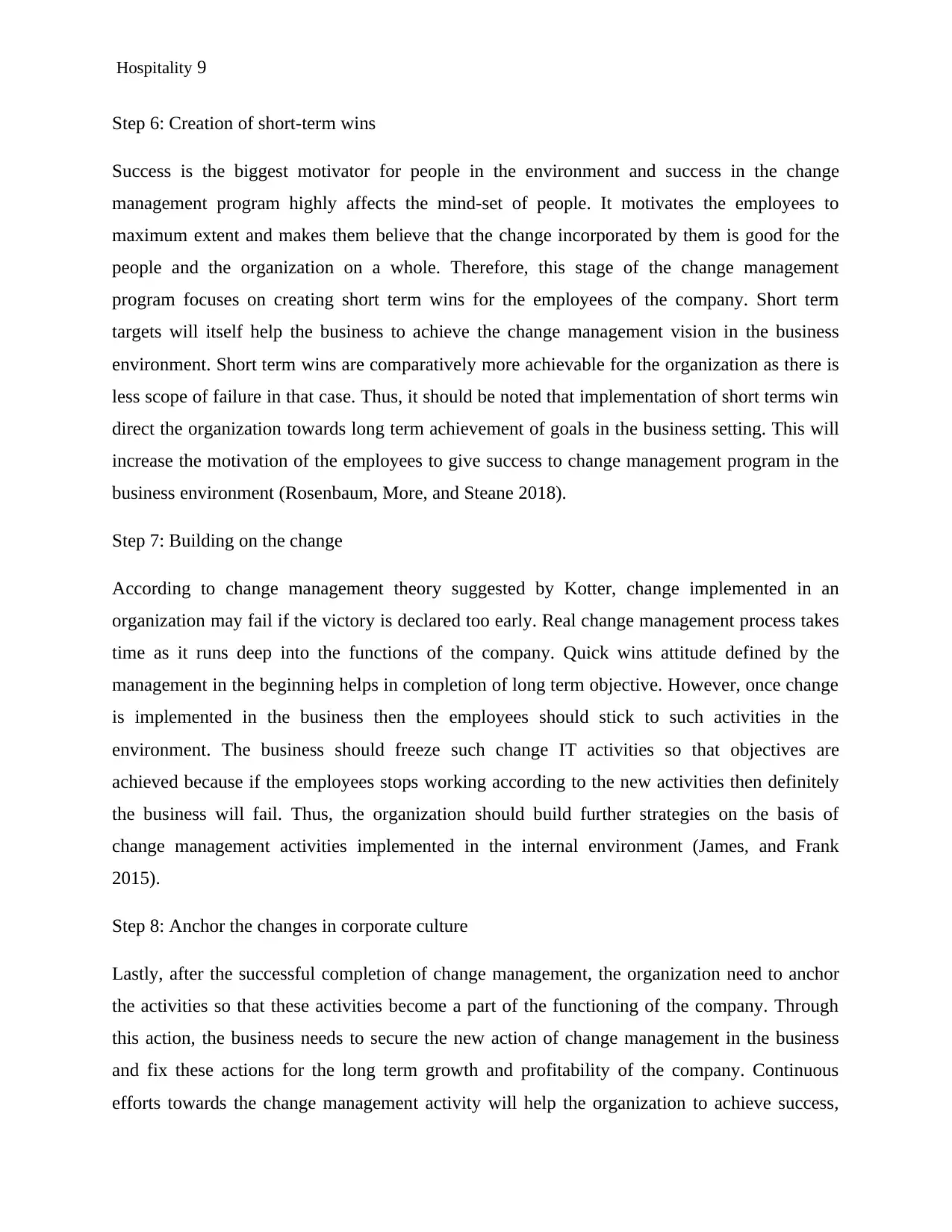
Hospitality 9
Step 6: Creation of short-term wins
Success is the biggest motivator for people in the environment and success in the change
management program highly affects the mind-set of people. It motivates the employees to
maximum extent and makes them believe that the change incorporated by them is good for the
people and the organization on a whole. Therefore, this stage of the change management
program focuses on creating short term wins for the employees of the company. Short term
targets will itself help the business to achieve the change management vision in the business
environment. Short term wins are comparatively more achievable for the organization as there is
less scope of failure in that case. Thus, it should be noted that implementation of short terms win
direct the organization towards long term achievement of goals in the business setting. This will
increase the motivation of the employees to give success to change management program in the
business environment (Rosenbaum, More, and Steane 2018).
Step 7: Building on the change
According to change management theory suggested by Kotter, change implemented in an
organization may fail if the victory is declared too early. Real change management process takes
time as it runs deep into the functions of the company. Quick wins attitude defined by the
management in the beginning helps in completion of long term objective. However, once change
is implemented in the business then the employees should stick to such activities in the
environment. The business should freeze such change IT activities so that objectives are
achieved because if the employees stops working according to the new activities then definitely
the business will fail. Thus, the organization should build further strategies on the basis of
change management activities implemented in the internal environment (James, and Frank
2015).
Step 8: Anchor the changes in corporate culture
Lastly, after the successful completion of change management, the organization need to anchor
the activities so that these activities become a part of the functioning of the company. Through
this action, the business needs to secure the new action of change management in the business
and fix these actions for the long term growth and profitability of the company. Continuous
efforts towards the change management activity will help the organization to achieve success,
Step 6: Creation of short-term wins
Success is the biggest motivator for people in the environment and success in the change
management program highly affects the mind-set of people. It motivates the employees to
maximum extent and makes them believe that the change incorporated by them is good for the
people and the organization on a whole. Therefore, this stage of the change management
program focuses on creating short term wins for the employees of the company. Short term
targets will itself help the business to achieve the change management vision in the business
environment. Short term wins are comparatively more achievable for the organization as there is
less scope of failure in that case. Thus, it should be noted that implementation of short terms win
direct the organization towards long term achievement of goals in the business setting. This will
increase the motivation of the employees to give success to change management program in the
business environment (Rosenbaum, More, and Steane 2018).
Step 7: Building on the change
According to change management theory suggested by Kotter, change implemented in an
organization may fail if the victory is declared too early. Real change management process takes
time as it runs deep into the functions of the company. Quick wins attitude defined by the
management in the beginning helps in completion of long term objective. However, once change
is implemented in the business then the employees should stick to such activities in the
environment. The business should freeze such change IT activities so that objectives are
achieved because if the employees stops working according to the new activities then definitely
the business will fail. Thus, the organization should build further strategies on the basis of
change management activities implemented in the internal environment (James, and Frank
2015).
Step 8: Anchor the changes in corporate culture
Lastly, after the successful completion of change management, the organization need to anchor
the activities so that these activities become a part of the functioning of the company. Through
this action, the business needs to secure the new action of change management in the business
and fix these actions for the long term growth and profitability of the company. Continuous
efforts towards the change management activity will help the organization to achieve success,
Secure Best Marks with AI Grader
Need help grading? Try our AI Grader for instant feedback on your assignments.
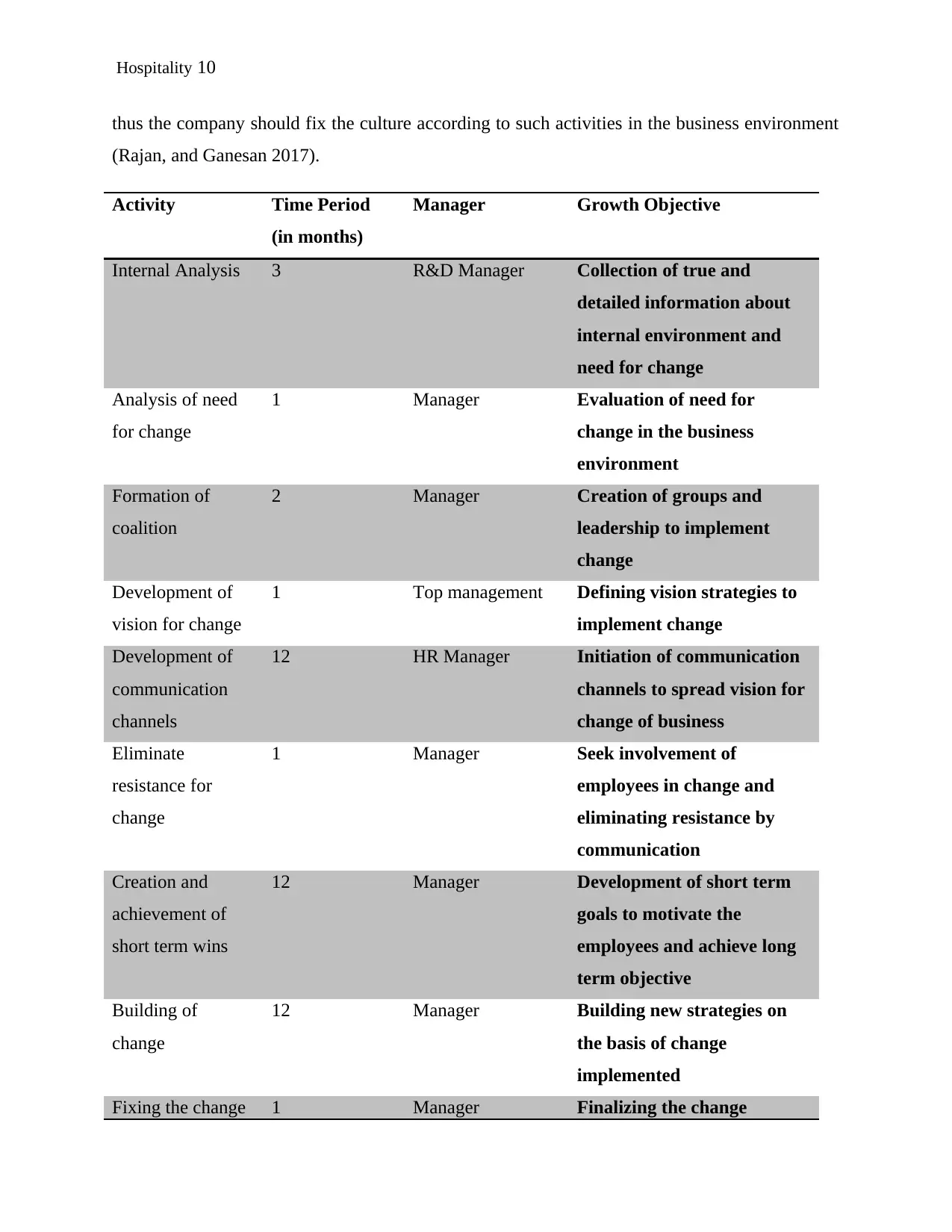
Hospitality 10
thus the company should fix the culture according to such activities in the business environment
(Rajan, and Ganesan 2017).
Activity Time Period
(in months)
Manager Growth Objective
Internal Analysis 3 R&D Manager Collection of true and
detailed information about
internal environment and
need for change
Analysis of need
for change
1 Manager Evaluation of need for
change in the business
environment
Formation of
coalition
2 Manager Creation of groups and
leadership to implement
change
Development of
vision for change
1 Top management Defining vision strategies to
implement change
Development of
communication
channels
12 HR Manager Initiation of communication
channels to spread vision for
change of business
Eliminate
resistance for
change
1 Manager Seek involvement of
employees in change and
eliminating resistance by
communication
Creation and
achievement of
short term wins
12 Manager Development of short term
goals to motivate the
employees and achieve long
term objective
Building of
change
12 Manager Building new strategies on
the basis of change
implemented
Fixing the change 1 Manager Finalizing the change
thus the company should fix the culture according to such activities in the business environment
(Rajan, and Ganesan 2017).
Activity Time Period
(in months)
Manager Growth Objective
Internal Analysis 3 R&D Manager Collection of true and
detailed information about
internal environment and
need for change
Analysis of need
for change
1 Manager Evaluation of need for
change in the business
environment
Formation of
coalition
2 Manager Creation of groups and
leadership to implement
change
Development of
vision for change
1 Top management Defining vision strategies to
implement change
Development of
communication
channels
12 HR Manager Initiation of communication
channels to spread vision for
change of business
Eliminate
resistance for
change
1 Manager Seek involvement of
employees in change and
eliminating resistance by
communication
Creation and
achievement of
short term wins
12 Manager Development of short term
goals to motivate the
employees and achieve long
term objective
Building of
change
12 Manager Building new strategies on
the basis of change
implemented
Fixing the change 1 Manager Finalizing the change
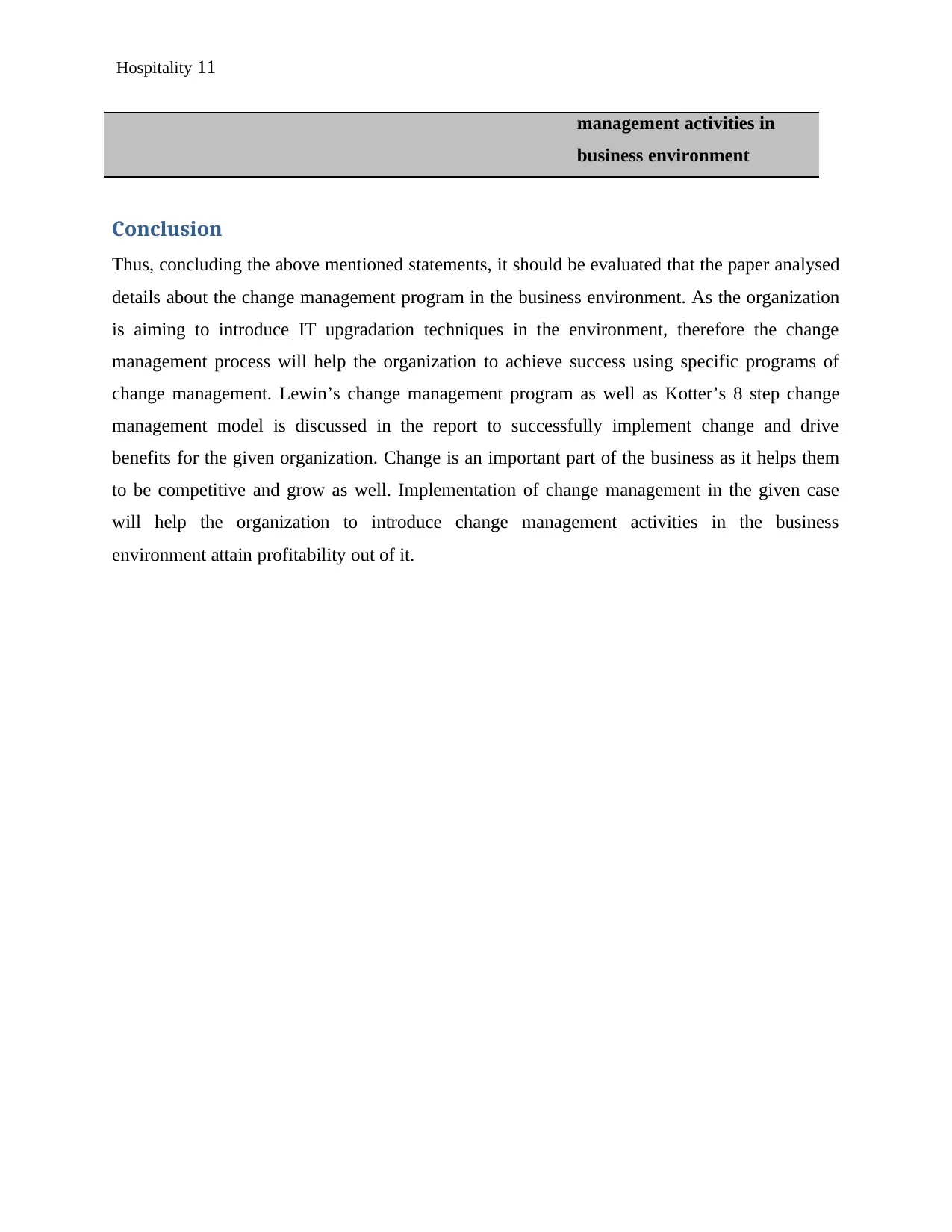
Hospitality 11
management activities in
business environment
Conclusion
Thus, concluding the above mentioned statements, it should be evaluated that the paper analysed
details about the change management program in the business environment. As the organization
is aiming to introduce IT upgradation techniques in the environment, therefore the change
management process will help the organization to achieve success using specific programs of
change management. Lewin’s change management program as well as Kotter’s 8 step change
management model is discussed in the report to successfully implement change and drive
benefits for the given organization. Change is an important part of the business as it helps them
to be competitive and grow as well. Implementation of change management in the given case
will help the organization to introduce change management activities in the business
environment attain profitability out of it.
management activities in
business environment
Conclusion
Thus, concluding the above mentioned statements, it should be evaluated that the paper analysed
details about the change management program in the business environment. As the organization
is aiming to introduce IT upgradation techniques in the environment, therefore the change
management process will help the organization to achieve success using specific programs of
change management. Lewin’s change management program as well as Kotter’s 8 step change
management model is discussed in the report to successfully implement change and drive
benefits for the given organization. Change is an important part of the business as it helps them
to be competitive and grow as well. Implementation of change management in the given case
will help the organization to introduce change management activities in the business
environment attain profitability out of it.
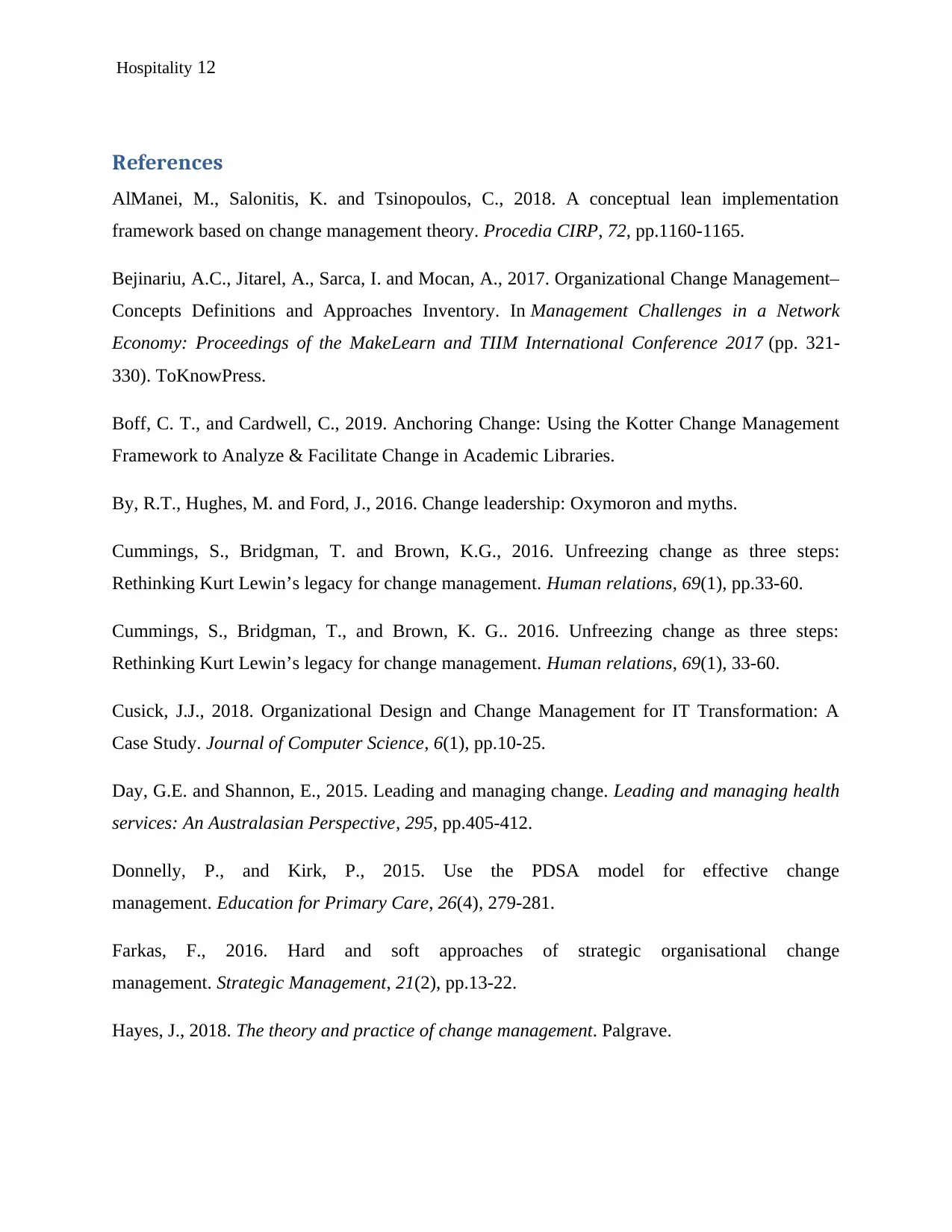
Hospitality 12
References
AlManei, M., Salonitis, K. and Tsinopoulos, C., 2018. A conceptual lean implementation
framework based on change management theory. Procedia CIRP, 72, pp.1160-1165.
Bejinariu, A.C., Jitarel, A., Sarca, I. and Mocan, A., 2017. Organizational Change Management–
Concepts Definitions and Approaches Inventory. In Management Challenges in a Network
Economy: Proceedings of the MakeLearn and TIIM International Conference 2017 (pp. 321-
330). ToKnowPress.
Boff, C. T., and Cardwell, C., 2019. Anchoring Change: Using the Kotter Change Management
Framework to Analyze & Facilitate Change in Academic Libraries.
By, R.T., Hughes, M. and Ford, J., 2016. Change leadership: Oxymoron and myths.
Cummings, S., Bridgman, T. and Brown, K.G., 2016. Unfreezing change as three steps:
Rethinking Kurt Lewin’s legacy for change management. Human relations, 69(1), pp.33-60.
Cummings, S., Bridgman, T., and Brown, K. G.. 2016. Unfreezing change as three steps:
Rethinking Kurt Lewin’s legacy for change management. Human relations, 69(1), 33-60.
Cusick, J.J., 2018. Organizational Design and Change Management for IT Transformation: A
Case Study. Journal of Computer Science, 6(1), pp.10-25.
Day, G.E. and Shannon, E., 2015. Leading and managing change. Leading and managing health
services: An Australasian Perspective, 295, pp.405-412.
Donnelly, P., and Kirk, P., 2015. Use the PDSA model for effective change
management. Education for Primary Care, 26(4), 279-281.
Farkas, F., 2016. Hard and soft approaches of strategic organisational change
management. Strategic Management, 21(2), pp.13-22.
Hayes, J., 2018. The theory and practice of change management. Palgrave.
References
AlManei, M., Salonitis, K. and Tsinopoulos, C., 2018. A conceptual lean implementation
framework based on change management theory. Procedia CIRP, 72, pp.1160-1165.
Bejinariu, A.C., Jitarel, A., Sarca, I. and Mocan, A., 2017. Organizational Change Management–
Concepts Definitions and Approaches Inventory. In Management Challenges in a Network
Economy: Proceedings of the MakeLearn and TIIM International Conference 2017 (pp. 321-
330). ToKnowPress.
Boff, C. T., and Cardwell, C., 2019. Anchoring Change: Using the Kotter Change Management
Framework to Analyze & Facilitate Change in Academic Libraries.
By, R.T., Hughes, M. and Ford, J., 2016. Change leadership: Oxymoron and myths.
Cummings, S., Bridgman, T. and Brown, K.G., 2016. Unfreezing change as three steps:
Rethinking Kurt Lewin’s legacy for change management. Human relations, 69(1), pp.33-60.
Cummings, S., Bridgman, T., and Brown, K. G.. 2016. Unfreezing change as three steps:
Rethinking Kurt Lewin’s legacy for change management. Human relations, 69(1), 33-60.
Cusick, J.J., 2018. Organizational Design and Change Management for IT Transformation: A
Case Study. Journal of Computer Science, 6(1), pp.10-25.
Day, G.E. and Shannon, E., 2015. Leading and managing change. Leading and managing health
services: An Australasian Perspective, 295, pp.405-412.
Donnelly, P., and Kirk, P., 2015. Use the PDSA model for effective change
management. Education for Primary Care, 26(4), 279-281.
Farkas, F., 2016. Hard and soft approaches of strategic organisational change
management. Strategic Management, 21(2), pp.13-22.
Hayes, J., 2018. The theory and practice of change management. Palgrave.
Paraphrase This Document
Need a fresh take? Get an instant paraphrase of this document with our AI Paraphraser
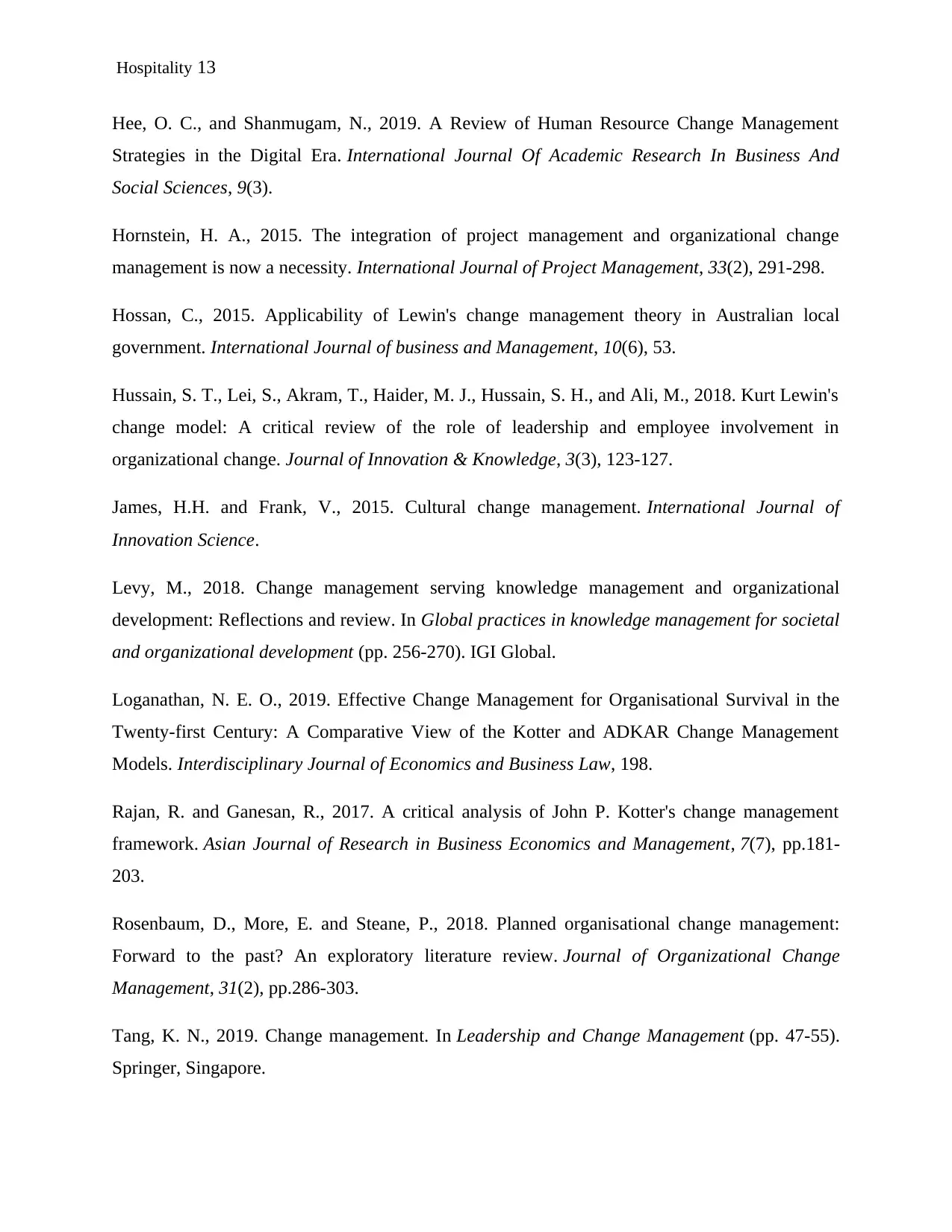
Hospitality 13
Hee, O. C., and Shanmugam, N., 2019. A Review of Human Resource Change Management
Strategies in the Digital Era. International Journal Of Academic Research In Business And
Social Sciences, 9(3).
Hornstein, H. A., 2015. The integration of project management and organizational change
management is now a necessity. International Journal of Project Management, 33(2), 291-298.
Hossan, C., 2015. Applicability of Lewin's change management theory in Australian local
government. International Journal of business and Management, 10(6), 53.
Hussain, S. T., Lei, S., Akram, T., Haider, M. J., Hussain, S. H., and Ali, M., 2018. Kurt Lewin's
change model: A critical review of the role of leadership and employee involvement in
organizational change. Journal of Innovation & Knowledge, 3(3), 123-127.
James, H.H. and Frank, V., 2015. Cultural change management. International Journal of
Innovation Science.
Levy, M., 2018. Change management serving knowledge management and organizational
development: Reflections and review. In Global practices in knowledge management for societal
and organizational development (pp. 256-270). IGI Global.
Loganathan, N. E. O., 2019. Effective Change Management for Organisational Survival in the
Twenty-first Century: A Comparative View of the Kotter and ADKAR Change Management
Models. Interdisciplinary Journal of Economics and Business Law, 198.
Rajan, R. and Ganesan, R., 2017. A critical analysis of John P. Kotter's change management
framework. Asian Journal of Research in Business Economics and Management, 7(7), pp.181-
203.
Rosenbaum, D., More, E. and Steane, P., 2018. Planned organisational change management:
Forward to the past? An exploratory literature review. Journal of Organizational Change
Management, 31(2), pp.286-303.
Tang, K. N., 2019. Change management. In Leadership and Change Management (pp. 47-55).
Springer, Singapore.
Hee, O. C., and Shanmugam, N., 2019. A Review of Human Resource Change Management
Strategies in the Digital Era. International Journal Of Academic Research In Business And
Social Sciences, 9(3).
Hornstein, H. A., 2015. The integration of project management and organizational change
management is now a necessity. International Journal of Project Management, 33(2), 291-298.
Hossan, C., 2015. Applicability of Lewin's change management theory in Australian local
government. International Journal of business and Management, 10(6), 53.
Hussain, S. T., Lei, S., Akram, T., Haider, M. J., Hussain, S. H., and Ali, M., 2018. Kurt Lewin's
change model: A critical review of the role of leadership and employee involvement in
organizational change. Journal of Innovation & Knowledge, 3(3), 123-127.
James, H.H. and Frank, V., 2015. Cultural change management. International Journal of
Innovation Science.
Levy, M., 2018. Change management serving knowledge management and organizational
development: Reflections and review. In Global practices in knowledge management for societal
and organizational development (pp. 256-270). IGI Global.
Loganathan, N. E. O., 2019. Effective Change Management for Organisational Survival in the
Twenty-first Century: A Comparative View of the Kotter and ADKAR Change Management
Models. Interdisciplinary Journal of Economics and Business Law, 198.
Rajan, R. and Ganesan, R., 2017. A critical analysis of John P. Kotter's change management
framework. Asian Journal of Research in Business Economics and Management, 7(7), pp.181-
203.
Rosenbaum, D., More, E. and Steane, P., 2018. Planned organisational change management:
Forward to the past? An exploratory literature review. Journal of Organizational Change
Management, 31(2), pp.286-303.
Tang, K. N., 2019. Change management. In Leadership and Change Management (pp. 47-55).
Springer, Singapore.
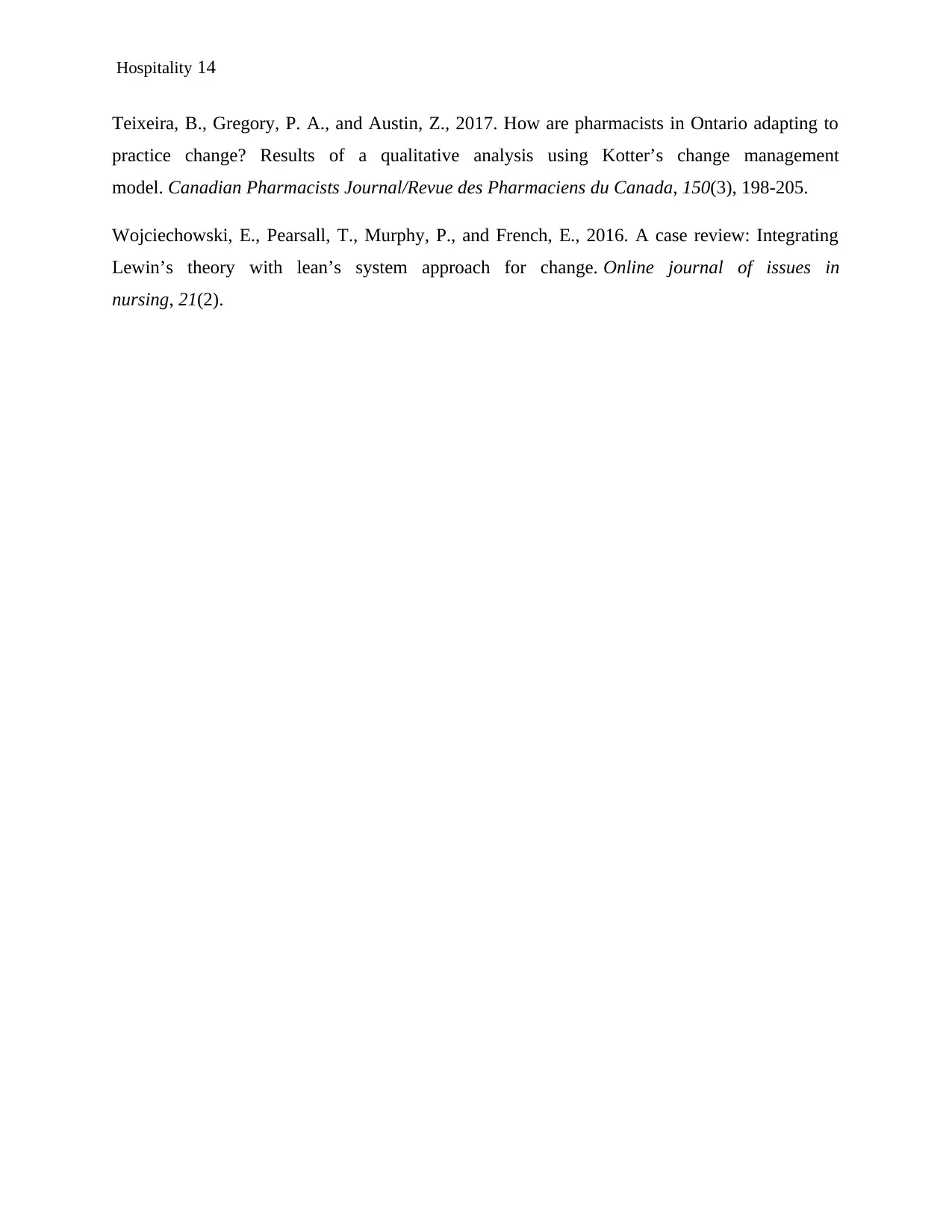
Hospitality 14
Teixeira, B., Gregory, P. A., and Austin, Z., 2017. How are pharmacists in Ontario adapting to
practice change? Results of a qualitative analysis using Kotter’s change management
model. Canadian Pharmacists Journal/Revue des Pharmaciens du Canada, 150(3), 198-205.
Wojciechowski, E., Pearsall, T., Murphy, P., and French, E., 2016. A case review: Integrating
Lewin’s theory with lean’s system approach for change. Online journal of issues in
nursing, 21(2).
Teixeira, B., Gregory, P. A., and Austin, Z., 2017. How are pharmacists in Ontario adapting to
practice change? Results of a qualitative analysis using Kotter’s change management
model. Canadian Pharmacists Journal/Revue des Pharmaciens du Canada, 150(3), 198-205.
Wojciechowski, E., Pearsall, T., Murphy, P., and French, E., 2016. A case review: Integrating
Lewin’s theory with lean’s system approach for change. Online journal of issues in
nursing, 21(2).
1 out of 15
Related Documents
Your All-in-One AI-Powered Toolkit for Academic Success.
+13062052269
info@desklib.com
Available 24*7 on WhatsApp / Email
![[object Object]](/_next/static/media/star-bottom.7253800d.svg)
Unlock your academic potential
© 2024 | Zucol Services PVT LTD | All rights reserved.





